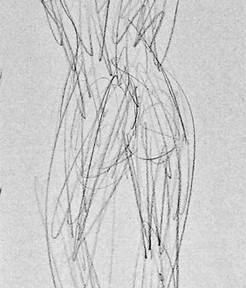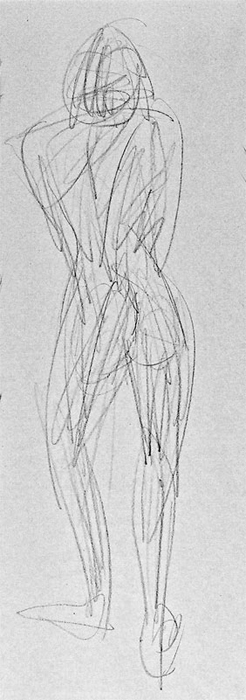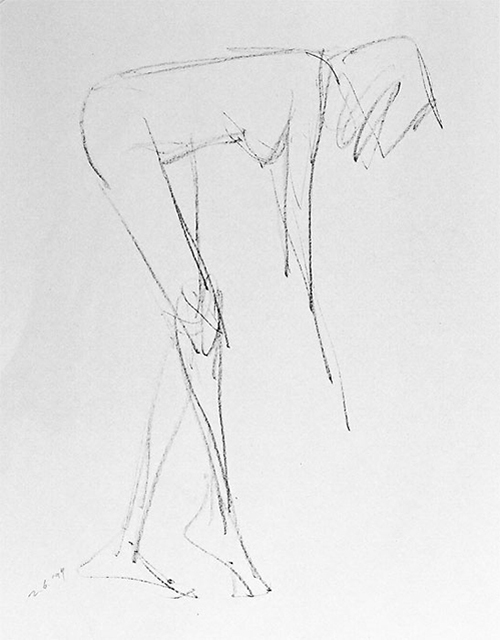Gesture drawing is a type of short drawing in which you try to express your feelings about the pose by drawing it in a simple and fast way. You need to use the most direct and effective approaches to draw the entire figure before the pose ends.
Gesture drawing is an essential exercise for “warming up” prior to a more extended drawing session. For a beginning level practice, an under-drawing could be used first:
Start the drawing with light and thick gesture lines to express the action and serve as the under-drawing. Do not draw detail, only the big shapes.
While it is advantageous to apply gesture drawing processes to every subject matter, it is indispensable with regard to figure drawing because of the human form’s inherent energy and potential for movement.
When applied to the figure, gesture drawing not only helps to energize you but also helps to energize the model. It gets the body moving and the blood flowing, which can in turn energize a sluggish brain.
Gesture drawing is a great exercise in and of itself, and it provides the perfect complement to a longer, more sustained drawing experience that eventually focuses on details and specifics.
The generalized nature of information gathered in a gesture drawing provides solid reinforcement for the process of working from general to specific and helps to gain experience in making rapid observations of overall figurative placement and proportion.
A typical gesture drawing or gesture pose lasts anywhere from three minutes to thirty seconds or even fifteen seconds.
To facilitate the qualities of energy and immediacy, hold your drawing material loosely so that you can utilize your entire arm.
Often the tendency is to grip the tool in the same way you would if writing, but writing generally requires more precise and constricted movement than is desirable in gesture drawing.
Seeing Is The Key
Spend some time just looking at the pose before you begin to draw. Spend the majority of your time looking at the model rather than at your drawing.
The movement of your hand should duplicate the movement of your eyes as you rapidly scan the figure for proportion and general disposition.
Establish general scale and proportion purely through visual observation. A formal use of the sighting stick and the sighting process is inappropriate in gesture drawing because of the limited time involved.
Stand at arm’s length from the drawing surface in a position allowing a broad view of both the model and your drawing surface. Keep your drawing surface at a height that is most comfortable for you.
Using Axis Lines
Use axis lines to indicate directional thrusts or to show the major masses of the body (head, upper torso or rib cage, lower torso or pelvis, limbs) in opposition.
You can indicate significant angles or angular relationships such as the angle of the head, the curve of the spine, the angular relationship between left and right shoulder, between left and right breast, or between left and right foot in a standing or crouching figure.
Be attentive to the shape and placement of the feet. The foot may seem like a minor element of the figure, but in fact it plays a very important role in anchoring the body. Finding the correct shape and placement of the foot is essential in creating a convincing ground plane that gives the figure its proper space and sense of weight and grounding.
Keeping It Simple
Details of the figure, such as facial features or individual fingers and toes, are unimportant in gesture drawing and should not be of concern.
Try to be economical with your marks – don’t overwork your gestures. Let gesture drawing be a statement of essentials or essence.
Define the general characteristics of the figure – movement or directional thrusts; shape; weight distribution or muscle tension (through weighted line); basic position of the head, hands, and feet; position in space; and so on.
Generally speaking, do not be concerned with light and dark value structure of the figure unless the emphasis is on sustained gesture, which is a variation of gesture drawing that allows for rapid and simplified indication of planes of light and shadow.
Setting The Pace
The figure and its position should be suggested in its entirety within the first few moments of drawing. This is accomplished by recording the largest and most apparent shapes and axis lines first.
Think energy and immediacy – gesture drawing is a record of the energy and movement that goes into making the marks.
Use the entire arm and wrist and shoulder to draw; use your whole body.
Stand up when doing gesture drawings to enable fluid and rapid drawing.
Working From The Inside Out
Have an awareness of underlying structure, which acts as the armature for the flesh of the figure. In a longer gesture drawing, you can indicate the simple underlying masses of the skeletal system – skull, rib cage, and pelvis – Using geometric simplification of these forms.
Indicate general points of articulation, such as the joining of the limbs with the torso. These are good places to cross over into the interior of the figure and to reinforce the idea that gesture drawing should not focus solely on outermost contours.
Line Variation In Figure Drawing
The human form provides a particularly rich opportunity to explore the relationship between line and edge and the power of line to convey tremendous nuance and subtlety or extreme power and forcefulness while addressing the physical aspects of volume, mass, movement, weight, gesture, dimension, and space.
The tremendous variety that is inherent in the human body, both at rest and in motion, explains in part its value in the study of drawing.
There is also a powerful psychological element that makes the study of the human form an especially rich and satisfying experience.
http://pxstudio.us/research/gesture-research/gesture-1/index.htm
http://pxstudio.us/research/gesture-research/gesture-2/index.htm



